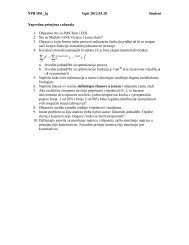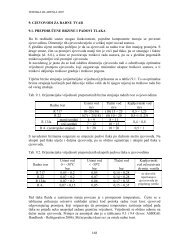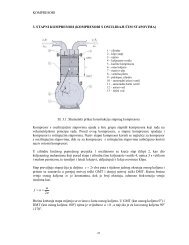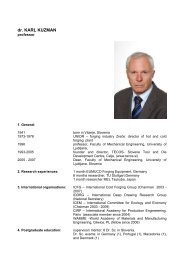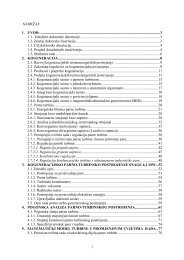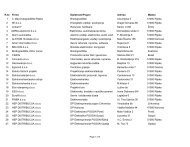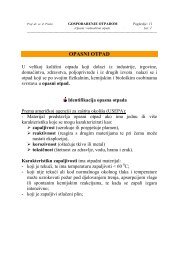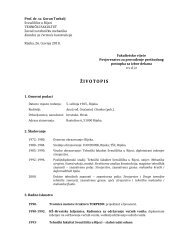universityâenterprise cooperation
universityâenterprise cooperation
universityâenterprise cooperation
Create successful ePaper yourself
Turn your PDF publications into a flip-book with our unique Google optimized e-Paper software.
and prosperity for entire population of the<br />
WBC region. Considering the fact that 98,9%<br />
of active enterprises in WBC region (Serbia,<br />
Montenegro, Bosnia and Herzegovina,<br />
Croatia) have been categorized as SME,<br />
with needs and operative procedures<br />
completely different from ones at large<br />
enterprises, the project will be focused on<br />
the development of global system support<br />
for those enterprises.<br />
2.2 Structure of the publication<br />
Besides the presentation of the new WBC<br />
regional model of university-enterprise<br />
<strong>cooperation</strong>, developed within the WBC-<br />
VMnet project, the objective of this<br />
publication is to point out the necessity<br />
of modernization of the universities in<br />
WBC region, through the integration of the<br />
knowledge triangle, and the establishment<br />
of <strong>cooperation</strong> between key actors in the<br />
areas of education, science and business.<br />
The baseline for the framework were the EU<br />
legislation, the challenges, policy, on one<br />
hand, and individuality and diversity in the<br />
WBC region on the other hand. Therefore,<br />
the structure of such publication starts from<br />
the goals of Europe in this field, through<br />
the identified needs, state of development<br />
in the WBC region, and further through<br />
the presentation of EU good practices<br />
in order to give the readers and users of<br />
the publication, as well as the implementers<br />
of a new regional model the opportunity to<br />
analyze them as case studies.<br />
Chapter 3 contains representation of EU<br />
legislation, policies and strategies, review<br />
of past experience, success factors, the<br />
EU incentives, recommendations and<br />
encouragements. In addition to this, there is<br />
a spreadsheet overview of main EU documents,<br />
produced by the EU Commission, working<br />
groups, or delivered within similar projects.<br />
Chapter 4 describes the current state in the<br />
areas that make up the knowledge triangle<br />
in the WBC region, particularly in member<br />
countries of the Consortium of WBC-VMnet<br />
project, the constraints and challenges,<br />
identified needs, as well as a brief description<br />
of some initiatives within the current TEMPUS<br />
projects. Besides a brief description of key<br />
institutions in the areas of higher education,<br />
research, innovation, social partners,<br />
there are also web-site addresses of most<br />
institutions that were presented, so that<br />
the interested parties can find additional<br />
information at the listed addresses.<br />
Fifteen collected EU practices are briefly<br />
described in Chapter 5, through the display<br />
of main features of university-enterprise<br />
<strong>cooperation</strong>. As in the previous chapter,<br />
the web addresses of centers, offices, key<br />
projects and programs that have been<br />
established and realized at EU universities<br />
are available to the readers of the publication.<br />
The objective of this is the dissemination of<br />
the best EU practice, raising awareness<br />
about the importance of integration of the<br />
knowledge triangle, i.e. the establishment<br />
of sustainable and effective <strong>cooperation</strong> of<br />
universities with enterprises.<br />
Chapter 6 deals with the presentation of<br />
the new WBC regional model of <strong>cooperation</strong><br />
between universities and enterprises,<br />
at the beginning of which are given the<br />
challenges and prospective views, as well as<br />
the benefits for key stakeholders. Bearing<br />
in mind the different level of development<br />
of the region, economic and historical<br />
background, the model is reduced to a series<br />
of recommendations for the establishment<br />
of aforementioned <strong>cooperation</strong>, primarily<br />
through mechanisms and structures as<br />
bearers of such <strong>cooperation</strong>. Future steps<br />
are given at the end.<br />
As this is the first publication in the WBC<br />
region, which refers to the knowledge<br />
triangle and <strong>cooperation</strong> of universities and<br />
enterprises, we hope that it would contribute<br />
to raising awareness among stakeholders and<br />
key actors, as well as to start a series of<br />
initiatives, projects, programs for establishing<br />
effective and sustainable structures for<br />
development of such <strong>cooperation</strong>.<br />
15<br />
Introduction 2




